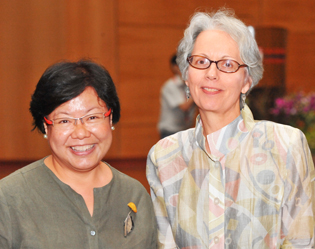Why Singapore’s English Teachers Should Embrace Singlish, Not Fight It
Is it time for Singaporean educators to embrace Singlish as a legitimate learning tool? What the Research […]
Read More
“There is an African proverb that says, ‘When an elder dies, a library burns down.’ The same is true of teaching,” says American educator and researcher Catherine Lewis. She was referring to how teachers are not able to benefit from the knowledge accumulated by experienced teachers.
One solution is the practice of lesson study. “Lesson study is a way of allowing teachers to share their knowledge,” she explains.
“It is a systematic way of building teachers’ knowledge together, and has shown impact on both teachers’ and students’ learning.”
The concept of lesson study is quite simple. Teachers work in teams to collaboratively plan a lesson unit. They then observe the research lesson together and reflect on how it can be improved.
 It’s really building a professional knowledge base for teaching that doesn’t just reside in documents but in teachers meeting together, carefully looking at a shared example, and then trying that in your own classroom,” explains Catherine.
It’s really building a professional knowledge base for teaching that doesn’t just reside in documents but in teachers meeting together, carefully looking at a shared example, and then trying that in your own classroom,” explains Catherine.
The focus in all of these processes is on how students learn. “You’re really looking at student learning and saying: Is this working for students? And if it’s not working, how do we as teachers need to change it to make it work?”
“Over time, when teachers work in lesson study, they go from saying ‘my students’ to saying ‘our students’,” notes Catherine.
“They come to realize that what they do as an individual teacher is not nearly as powerful as what the whole school does.”
Lesson study presents a very practical approach to designing better lessons. In Japan, where lesson study originated, it is seen as a powerful means of enhancing teacher capacity and heightening teachers’ sensitivity to how their students are learning.
– Catherine Lewis,
Mills College, California
Japanese teachers often say, lesson study develops the eyes to see children,” says Catherine. “When you’re doing lesson study, and you’re an observing teacher, you’re an extra pair of eyes and an extra pair of ears, but not an extra mouth, not an extra pair of hands.”
It has also become a useful means of informing policy-making. “In Japan, policymakers realize that even the most carefully crafted policies are just blots of ink on paper until teachers bring them to life in a classroom,” shares Catherine. “It’s that bringing to life in the classroom that becomes the centre of learning.”
Thus, when the Japanese want to introduce a new topic into the curriculum, interested schools volunteer to be “research schools” to experiment with various ways of teaching the topic, for which they receive a small research stipend. At the end of a year, many of them conduct public research lessons to share what they have learned with teachers from other schools.
To ensure that the focus is on student learning, and not an evaluation of the teacher, the practice of lesson study is guided by careful protocols. There are at least two key protocols.
The first is the observation protocol. “You need to carefully observe what the students are doing and saying, not just whether they are giving the right answers,” Catherine reminds us. “You’re not there to help the students or to teach them; you’re there to take careful notes on their learning. By carefully sitting and watching, you’re really listening to the children. You can’t learn from children unless you’re quiet yourself.”
– Christine Lee on the value of lesson study
There is also the discussion protocol. In the post-research lesson discussions, the teacher who taught the lesson speaks first. “The unspoken understanding is that if something was a problem, they get to be the first one to identify it. The conversation focuses on the students, not on the teacher or the teaching.”
Comments from the other team members are likewise focused on what the students were doing and how they responded. “It’s careful, principled description of students, not leaping into inferences or into evaluation. They don’t say, ‘I liked this’, or ‘I liked that’. They say, ‘I was watching this student and this student used this method’, or ‘This was where they encountered a barrier’.”
When put together, these descriptions help us to get a picture of how the lesson was for different students. We can then begin to naturally draw the implications.
Catherine says implementing lesson study requires “a big culture change”. It requires that teachers investigate their own practice, to find out what works best in their classroom, rather than just implementing policy.
It also requires openness and mutual trust as classrooms become less private. More importantly, “You need a sense that however many years I’ve been teaching, I can still learn; and a sense that the children need to be our teachers.”
As teachers work together in lesson study – as they enter into “research mode” – they develop a shared vision of teaching the best lessons. Lesson study helps teachers to grow by understanding how students learn.
“It should help teachers rediscover the joy of learning.”